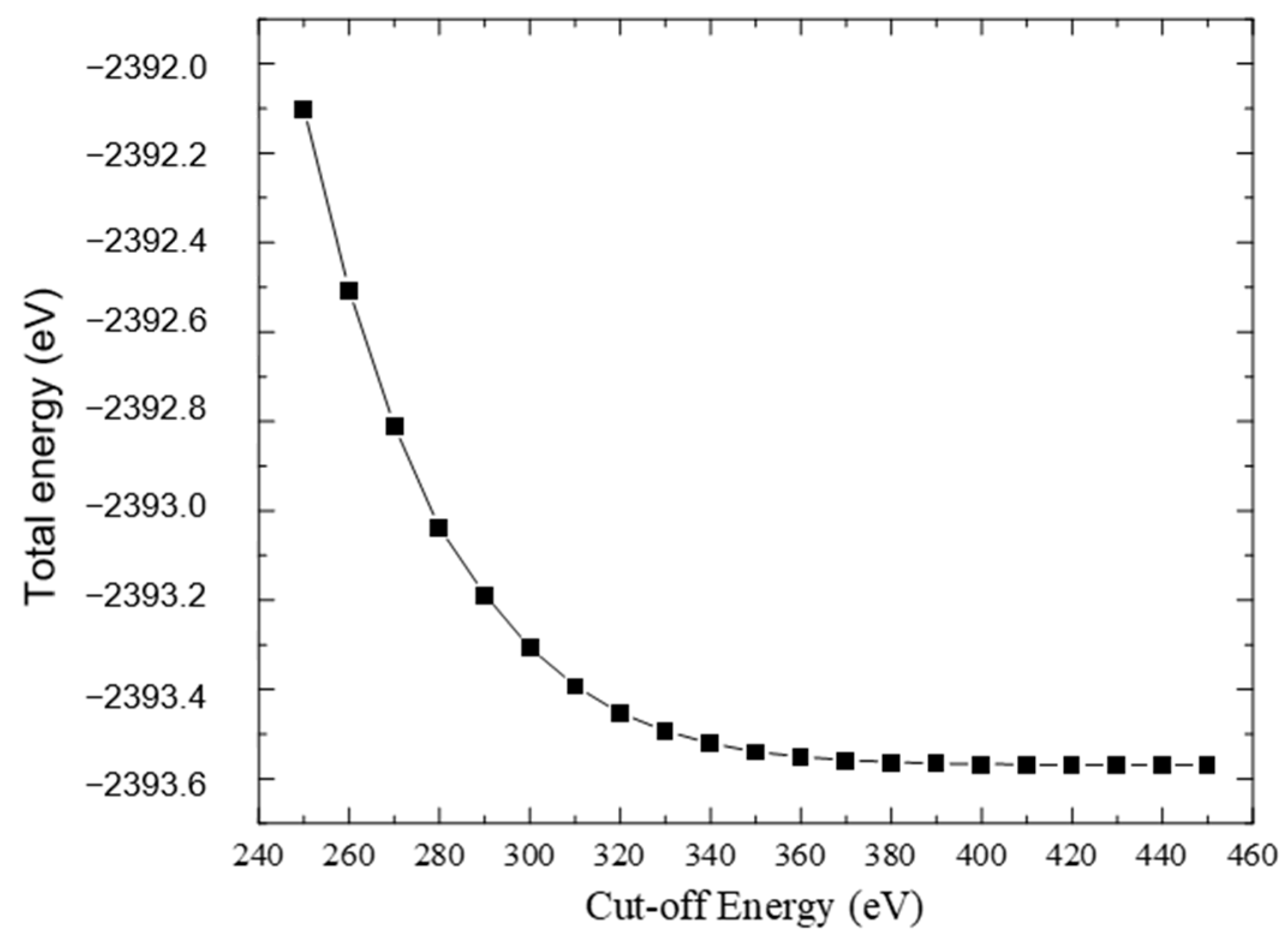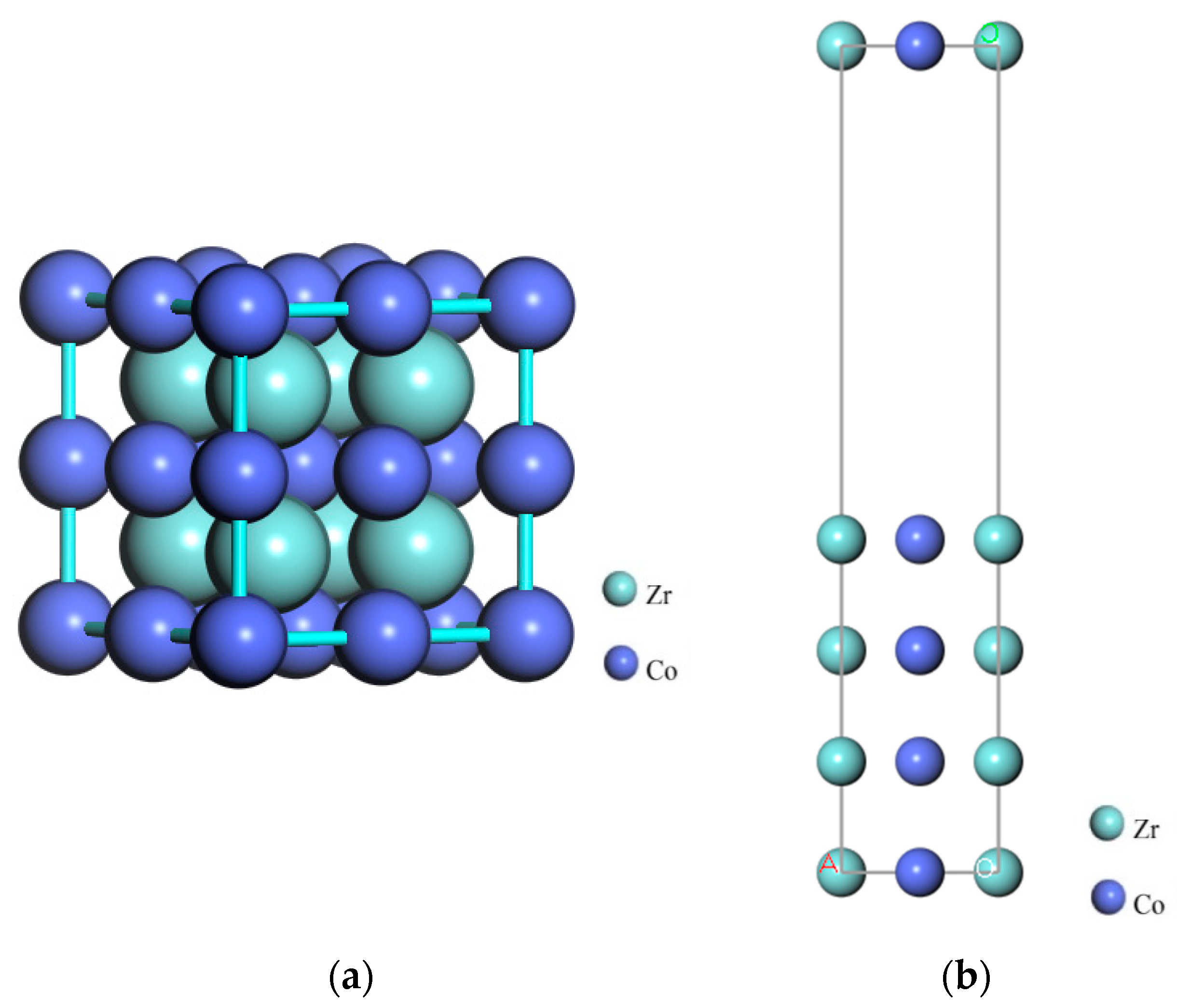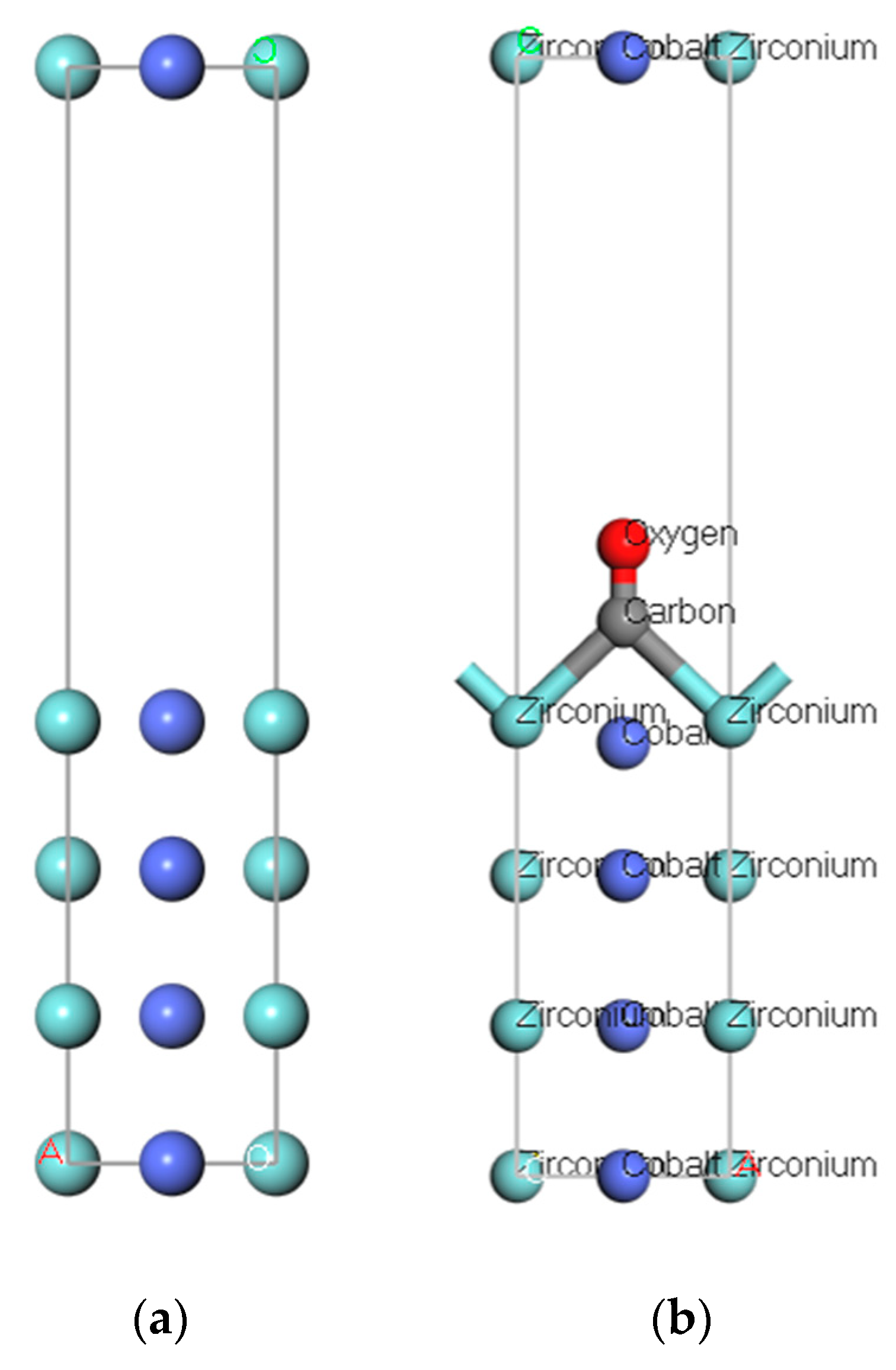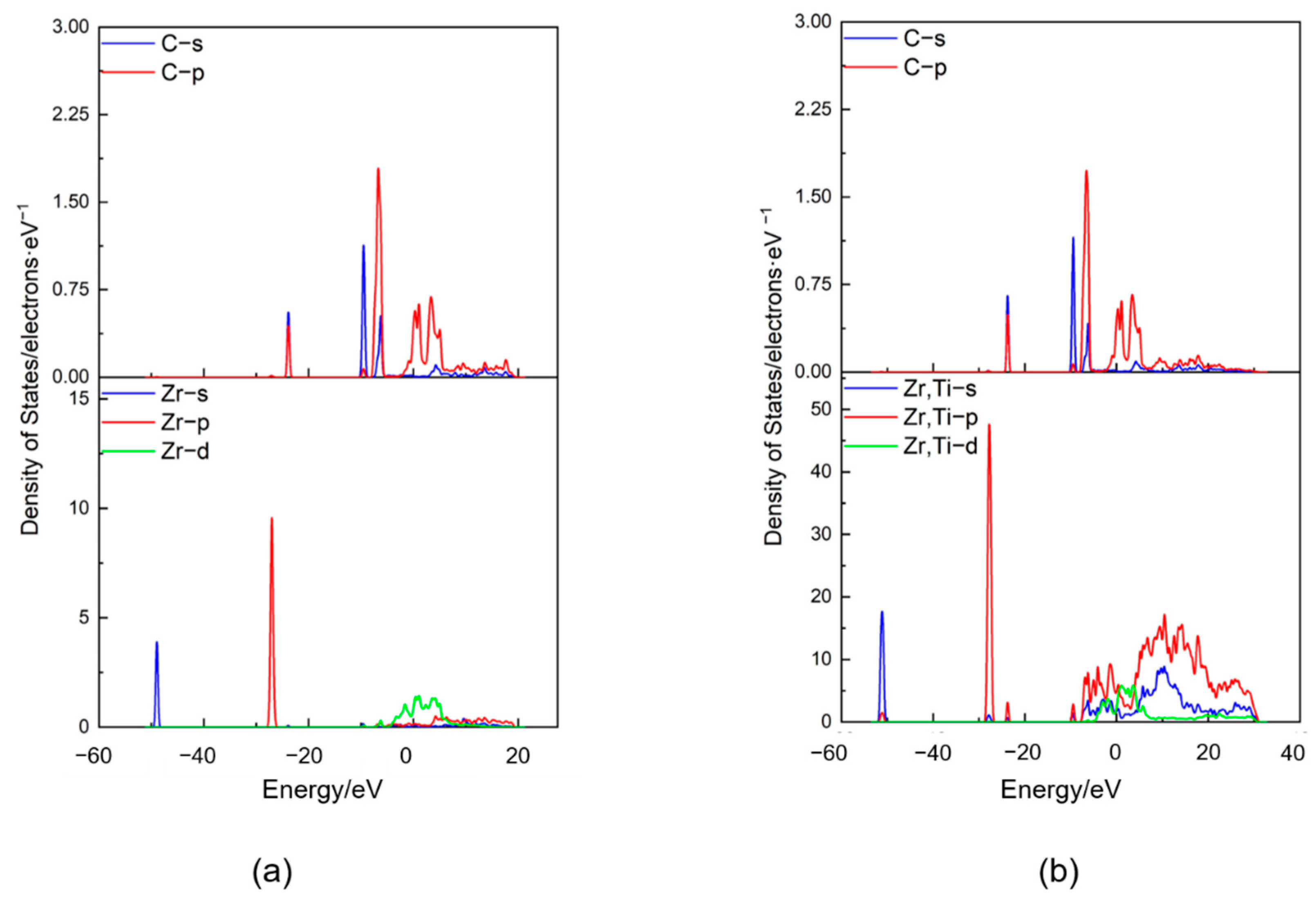First-Principles Study of the Effect of Titanium Doping on Carbon Monoxide Poisoning Properties of Zirconium-Cobalt Alloys
Abstract
:1. Introduction
2. Computational Model and Methods
3. Results and Discussion
3.1. Adsorption Energy, Final Adsorption Distance, and C-O Bond Length
3.2. Crystal Structure
3.3. Density of States
3.4. Charge Density Difference
4. Conclusions
- The adsorption energy for CO gas on the surface of the Zr0.8Ti0.2Co alloy (110) after Ti doping was higher than that of the ZrCo alloy (110) surface, which indicated that the Zr0.8Ti0.2Co alloy would be more susceptible to CO impurity gas poisoning.
- In the Zr0.8Ti0.2Co alloy (110) after Ti doping, there was orbital hybridization between the s and p orbital of C atom and the s and p orbital of Zr and Ti atom, which resulted in easier adsorption by CO.
- Moreover, the charge transfer analysis showed that the bonding of the C atom with Zr and Ti atoms in the Ti-doped system was stronger than that of C and Zr atom bonding in the pure system. After Ti doping, the charge density around the Zr and Ti atoms was higher, which indicated that the Ti atom had stronger charge interactions with the surrounding atoms and was not conducive to its antitoxicity performance.
Author Contributions
Funding
Institutional Review Board Statement
Informed Consent Statement
Data Availability Statement
Acknowledgments
Conflicts of Interest
References
- Chattaraj, D.; Parida, S.C.; Dash, S.; Majumder, C. Density functional study of vibrational, thermodynamic and elastic properties of ZrCo and ZrCoX3 (X = H, D and T) compounds. J. Alloys Compd. 2015, 629, 297–304. [Google Scholar] [CrossRef]
- Zhang, F.; Zhao, P.; Niu, M.; Maddy, J. The survey of key technologies in hydrogen energy storage. Int. J. Hydrogen Energy 2016, 41, 14535–14552. [Google Scholar] [CrossRef]
- Von Colbe, J.B.; Ares, J.-R.; Barale, J.; Baricco, M.; Buckley, C.; Capurso, G.; Gallandat, N.; Grant, D.M.; Guzik, M.N.; Jacob, I.; et al. Application of hydrides in hydrogen storage and compression: Achievements, outlook and perspectives. Int. J. Hydrogen Energy 2019, 44, 7780–7808. [Google Scholar] [CrossRef]
- Kojima, Y. Hydrogen storage materials for hydrogen and energy carriers. Int. J. Hydrogen Energy 2019, 44, 18179–18192. [Google Scholar] [CrossRef]
- Wang, F.; Li, R.; Ding, C.; Tang, W.; Wang, Y.; Xu, S.; Yu, R.; Wu, Y. Recent progress on the hydrogen storage properties of ZrCo-based alloys applied in International Thermonuclear Experimental Reactor (ITER). Prog. Nat. Sci.-Mater. Int. 2017, 27, 64–71. [Google Scholar] [CrossRef]
- Devillers, M.; Sirch, M.; Penzhorn, R.D. Hydrogen-induced disproportionation of the intermetallic zirconium-cobalt compound ZrCo. Chem. Mater. 1992, 4, 631–639. [Google Scholar] [CrossRef]
- Liang, Z.; Xiao, X.; Yao, Z.; Kou, H.; Luo, W.; Chen, C.; Chen, L. A new strategy for remarkably improving anti-disproportionation performance and cycling stabilities of ZrCo-based hydrogen isotope storage alloys by Cu substitution and controlling cutoff desorption pressure. Int. J. Hydrogen Energy 2019, 44, 28242–28251. [Google Scholar] [CrossRef]
- Zhang, G.; Sang, G.; Xiong, R.; Kou, H.; Liu, K.; Luo, W. Effects and mechanism of Ti, Ni, Sc, Fe substitution on the thermal stability of zirconium cobalt–hydrogen system. Int. J. Hydrogen Energy 2015, 40, 6582–6593. [Google Scholar] [CrossRef]
- Kou, H.; Sang, G.; Luo, W.; Huang, Z.; Meng, D.; Zhang, G.; Deng, J.; Luo, Z.; He, W.; Hu, C. Comparative study of full-scale thin double-layered annulus beds loaded with ZrCo, Zr0.8Hf0.2Co and Zr0.8Ti0.2Co for recovery and delivery of hydrogen isotopes. Int. J. Hydrogen Energy 2015, 40, 10923–10933. [Google Scholar] [CrossRef]
- Zhao, Y.; Li, R.; Tang, R.; Li, B.; Yu, R.; Liu, W.; Kou, H.; Meng, J. Effect of Ti substitution on hydrogen storage properties of Zr1−xTixCo (x = 0, 0.1, 0.2, 0.3) alloys. J. Energy Chem. 2014, 23, 9–14. [Google Scholar] [CrossRef]
- Yao, Z.; Xiao, X.; Liang, Z.; Kou, H.; Luo, W.; Chen, C.; Jiang, L.; Chen, L. Improvement on the kinetic and thermodynamic characteristics of Zr1-xNbxCo (x = 0–0.2) alloys for hydrogen isotope storage and delivery. J. Alloys Compd. 2019, 784, 1062–1070. [Google Scholar] [CrossRef]
- Weng, C.; Xiao, X.; Huang, X.; Jiang, F.; Yao, Z.; Li, S.; Ge, H.; Chen, L. Effect of Mn substitution for Co on the structural, kinetic, and thermodynamic characteristics of ZrCo1-xMnx (x = 0–0.1) alloys for tritium storage. Int. J. Hydrogen Energy 2017, 42, 28498–28506. [Google Scholar] [CrossRef]
- Zhang, G.; Tang, T.; Sang, G.; Xiong, Y. Effect of Ti Modification on Hydrogenation Properties of ZrCo in the Presence of CO Contaminant Gas. Rare Met. Mater. Eng. 2017, 46, 3366–3373. [Google Scholar]
- Penzhorn, R.D.; Devillers, M.; Sirch, M. Storage of tritium in ZrCo alloy: Effect of pre-exposure to impurities relevant to the fusion fuel cycle. J. Nucl. Mater. 1991, 179, 863–866. [Google Scholar] [CrossRef]
- Glasbrenner, H.; Klewe-Nebenius, H.; Bruns, M.; Pfennig, G.; Penzhorn, R.-D.; Ache, H.J. Surface analytical investigation of the tritium getter ZrCo after exposure to various gases. Microchim. Acta 1992, 107, 207–217. [Google Scholar] [CrossRef]
- Prigent, J.; Latroche, M.; Leoni, E.; Rohr, V. Hydrogen trapping properties of Zr-based intermetallic compounds in the presence of CO contaminant gas. J. Alloys Compd. 2011, 509, S801–S803. [Google Scholar] [CrossRef]
- Li, Z.; Li, H.; Wang, S.; Jiang, L.; Zhang, L.; Liu, X. Preparation and research on poisoning resistant Zr-Co based hydrogen storage alloys. Rare Met. 2008, 27, 367–370. [Google Scholar] [CrossRef]
- Guo, X.; Wang, S.; Li, Z.; Yuan, B.; Ye, J.; Qiu, H.; Wu, Y.; Liu, X.; Jiang, L. Study on the poisoning resistance of Pd-coated ZrCo alloy prepared by electroless plating method. Fusion Eng. Des. 2016, 113, 195–200. [Google Scholar] [CrossRef]
- Yang, G.; Liu, W.; Han, X.; Han, H.; Qian, Y.; Zeng, Y.; Wu, X.; Qiu, J.; Yin, H.; Liu, W.; et al. Effects of alloying substitutions on the anti-disproportionation behavior of ZrCo alloy. Int. J. Hydrogen Energy 2017, 42, 15782–15789. [Google Scholar] [CrossRef]
- Peng, L.; Jiang, C.; Xu, Q.; Wu, X. Hydrogen-induced disproportionation characteristics of Zr(1 − x)Hf(x)Co(x = 0, 0.1, 0.2 and 0.3) alloys. Fusion Eng. Des. 2013, 88, 299–303. [Google Scholar] [CrossRef]
- Liu, J.; Gao, T.; Wang, Q.; Wan, L.; Sang, G.; Zhang, G.; Han, H. New insights into the anti-disproportionation mechanism of ZrCo alloying with Ti, Hf, Sc, Cu, and Fe elements. Int. J. Hydrogen Energy 2020, 45, 28985–28995. [Google Scholar] [CrossRef]
- Tang, Q.-L.; Duan, X.-X.; Liu, B.; Wei, A.-Q.; Liu, S.-L.; Wang, Q.; Liang, Y.-P.; Ma, X.-H. A density functional study on properties of a Cu3Zn material and CO adsorption onto its surfaces. Appl. Surf. Sci. 2016, 363, 128–139. [Google Scholar] [CrossRef]
- Clark, S.J.; Segall, M.D.; Pickard, C.J.; Hasnip, P.J.; Probert, M.I.J.; Refson, K.; Payne, M.C. First principles methods using CASTEP. Z. Krist. Cryst. Mater. 2005, 220, 567–570. [Google Scholar] [CrossRef] [Green Version]
- Garrity, K.F.; Bennett, J.W.; Rabe, K.M.; Vanderbilt, D. Pseudopotentials for high-throughput DFT calculations. Comput. Mater. Sci. 2014, 81, 446–452. [Google Scholar] [CrossRef] [Green Version]
- Yuk, S.F.; Asthagiri, A. A first-principles study of Pt thin films on SrTiO3(1 0 0): Support effects on CO adsorption. J. Chem. Phys. 2015, 142, 24704. [Google Scholar] [CrossRef]
- Chattaraj, D.; Parida, S.; Dash, S.; Majumder, C. Structural, electronic and thermodynamic properties of ZrCo and ZrCoH3: A first-principles study. Int. J. Hydrogen Energy 2012, 37, 18952–18958. [Google Scholar] [CrossRef]
- Zhang, H.-P.; Luo, X.-G.; Lin, X.-Y.; Lu, X.; Leng, Y.; Song, H.-T. Density functional theory calculations on the adsorption of formaldehyde and other harmful gases on pure, Ti-doped, or N-doped graphene sheets. Appl. Surf. Sci. 2013, 283, 559–565. [Google Scholar] [CrossRef]
- Gachon, J.C.; Selhaoui, N.; Aba, B.; Hertz, J. Comparison between measured and predicted enthalpies of formation. J. Phase Equilibria 1992, 13, 506–511. [Google Scholar] [CrossRef]
- Wang, X.T.; Cui, Y.T.; Liu, X.F.; Liu, G.D. Electronic structures and magnetism in the Li2AgSb-type Heusler alloys, Zr2CoZ (Z= Al, Ga, In, Si, Ge, Sn, Pb, Sb): A first-principles study. J. Magn. Magn. Mater. 2015, 394, 50–59. [Google Scholar] [CrossRef]
- Wang, L.; Zhao, J.; Wang, L.; Yan, T.; Sun, Y.-Y.; Zhang, S.B. Titanium-decorated graphene oxide for carbon monoxide capture and separation. Phys. Chem. Chem. Phys. 2011, 13, 21126–21131. [Google Scholar] [CrossRef]





| Cut-Off Energy (eV) | k-Points | Convergence Criteria | |||
|---|---|---|---|---|---|
| Total Energy (×10−6 eV/atom) | Lattice Stress (GPa) | Interaction between Atoms (eV/Å) | Maximum Atomic Displacement (×10−4 Å) | ||
| 400 | Fine | 5 | 0.02 | 0.01 | 5 |
| Model | ΔEads/eV | Distance/Å | Bond Length/Å |
|---|---|---|---|
| CO on ZrCo (110) | −1.031 | 1.863 | 1.169 |
| CO on Zr0.8Ti0.2Co (110) | −1.662 | 1.744 | 1.173 |
| System | Lattice Constant (Å) | Volume (Å3) |
|---|---|---|
| ZrCo | 3.181 | 32.19 |
| Zr0.8Ti0.2Co | 3.147 | 31.17 |
| System | Energy (eV) |
|---|---|
| ZrCo | −7.418 |
| Zr0.8Ti0.2Co | −7.376 |
Publisher’s Note: MDPI stays neutral with regard to jurisdictional claims in published maps and institutional affiliations. |
© 2022 by the authors. Licensee MDPI, Basel, Switzerland. This article is an open access article distributed under the terms and conditions of the Creative Commons Attribution (CC BY) license (https://creativecommons.org/licenses/by/4.0/).
Share and Cite
Zhao, S.; Zeng, X.; Wang, Y.; Luo, B.; Wang, F. First-Principles Study of the Effect of Titanium Doping on Carbon Monoxide Poisoning Properties of Zirconium-Cobalt Alloys. Crystals 2022, 12, 1015. https://doi.org/10.3390/cryst12081015
Zhao S, Zeng X, Wang Y, Luo B, Wang F. First-Principles Study of the Effect of Titanium Doping on Carbon Monoxide Poisoning Properties of Zirconium-Cobalt Alloys. Crystals. 2022; 12(8):1015. https://doi.org/10.3390/cryst12081015
Chicago/Turabian StyleZhao, Shixiang, Xiangguo Zeng, Yuntian Wang, Bosang Luo, and Fang Wang. 2022. "First-Principles Study of the Effect of Titanium Doping on Carbon Monoxide Poisoning Properties of Zirconium-Cobalt Alloys" Crystals 12, no. 8: 1015. https://doi.org/10.3390/cryst12081015
APA StyleZhao, S., Zeng, X., Wang, Y., Luo, B., & Wang, F. (2022). First-Principles Study of the Effect of Titanium Doping on Carbon Monoxide Poisoning Properties of Zirconium-Cobalt Alloys. Crystals, 12(8), 1015. https://doi.org/10.3390/cryst12081015






